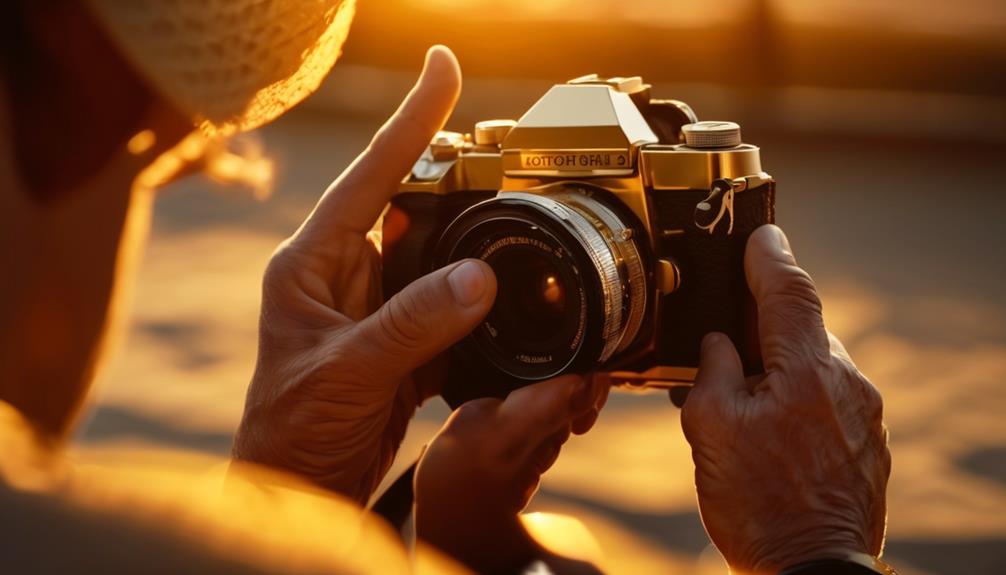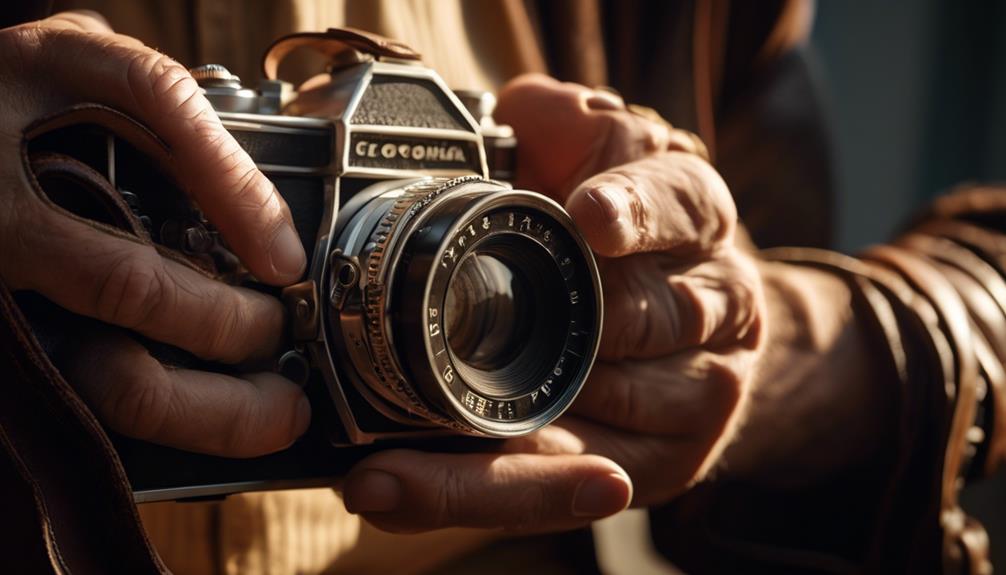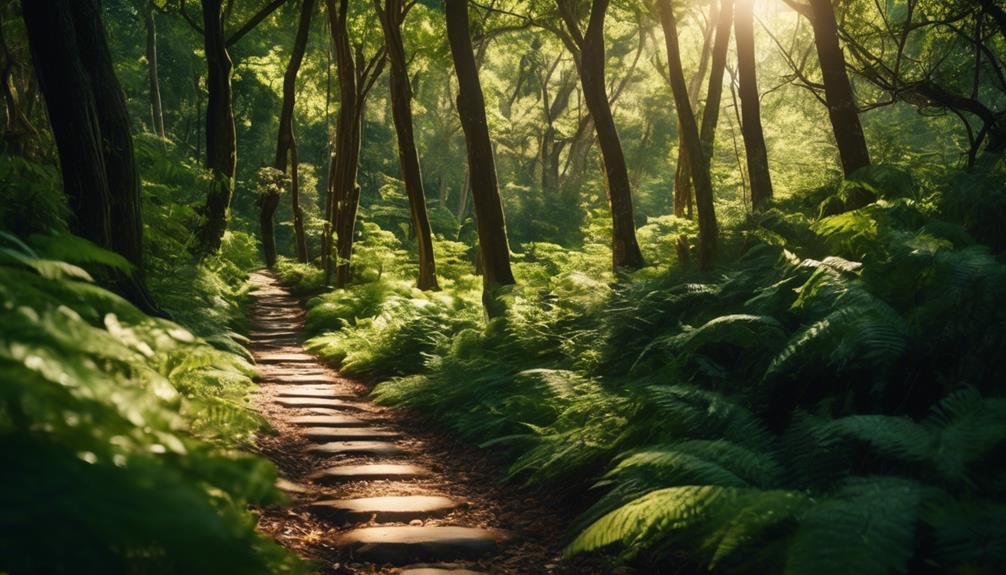Please note this post may contain affiliate links picked by me (Jay) that I have deemed may be of interest or relevant to you the reader of this.
These links do not affect the cost of the thing if you decide to purchase but i may get a little money if you choose to purchase.
For more information on my affiliate link policy click here.
I know what you might be thinking – with so many photographers out there, how can I possibly develop a unique style that sets me apart? Well, let me tell you, it's not as daunting as it seems.
In fact, by following these 8 steps, you'll be well on your way to creating a photography style that is truly one-of-a-kind. From exploring different genres to experimenting with lighting techniques, each step will help you uncover your own creative voice and bring a fresh perspective to your work.
So, let's dive in and discover the secrets to cultivating a unique photography style that will captivate and inspire.
Key Takeaways
- Explore different photography genres and study the work of other photographers to find your artistic voice and inspiration.
- Experiment with lighting techniques and develop a signature editing style to enhance your photographs and artistic vision.
- Incorporate composition techniques and creative use of props to add depth and storytelling to your photography.
- Use locations, props, lighting, symbolism, and decisive moments to incorporate storytelling elements into your photographs.
Explore Different Photography Genres
When it comes to developing a unique photography style, one of the most exciting and rewarding steps is to explore different photography genres. By delving into various genres, photographers can push their creative boundaries, experiment with different techniques, and find their true artistic voice. This process not only helps in discovering new ways to capture images but also allows photographers to express themselves in a way that's authentic and innovative.
Composition techniques play a crucial role in photography genres. The way elements are arranged within the frame can greatly impact the overall visual impact of the image. By exploring genres such as landscape, portrait, or street photography, photographers can learn various composition techniques and apply them to their own style. For instance, in landscape photography, the rule of thirds can be used to create a balanced and visually appealing image, while in portrait photography, the use of leading lines can guide the viewer's eye towards the subject.
Another important aspect to consider when exploring different genres is mastering depth of field. Depth of field refers to the range of sharpness in an image, from the foreground to the background. By experimenting with genres such as macro photography or still life photography, photographers can understand how different aperture settings can affect the depth of field and create different visual effects. This knowledge can then be applied to their own unique style, allowing them to create images with a distinct and captivating depth.
Study the Work of Other Photographers
Studying the work of other photographers is an essential step in developing a unique photography style, as it provides inspiration, insights, and a deeper understanding of the art form. By analyzing composition and understanding color theory, photographers can gain valuable knowledge that can be applied to their own work.
When studying the work of other photographers, one of the first things to look at is their composition. Composition refers to how elements are arranged within a photograph, such as the placement of subjects, lines, and shapes. By analyzing the composition of other photographers' work, you can start to identify patterns and techniques that you can incorporate into your own style. This can help you create visually interesting and balanced images that stand out from the crowd.
Understanding color theory is another important aspect of studying the work of other photographers. Colors evoke different emotions and can greatly impact the overall mood of a photograph. By observing how other photographers use color in their work, you can learn how to effectively communicate and convey your own artistic vision. Whether it's using complementary colors to create a sense of harmony or contrasting colors to create visual tension, studying the work of others can help you develop a unique and cohesive color palette in your own photography.
Experiment With Different Lighting Techniques
Now that we've explored the composition and color theory aspects of studying other photographers' work, it's time to delve into the exciting world of experimenting with different lighting techniques to further develop your unique photography style.
Lighting plays a crucial role in photography. It has the power to transform a mundane scene into a captivating masterpiece. By experimenting with different lighting techniques, you can add depth, drama, and intrigue to your photographs, creating a style that's truly your own.
One way to achieve creative compositions is by playing with shadows. Shadows can add a sense of mystery and depth to your images, making them visually striking. You can experiment with different angles and intensities of light to create interesting shadow patterns. For example, by positioning your subject between the light source and the camera, you can create a silhouette effect that emphasizes the shape and form of the subject.
Another lighting technique to explore is using natural light to your advantage. The soft, diffused light during golden hour, which occurs shortly after sunrise or before sunset, can add a warm and ethereal quality to your photographs. On the other hand, harsh light during midday can create bold and dramatic contrasts. By understanding how different lighting conditions affect your subjects, you can make informed decisions and capture stunning images.
Additionally, you can experiment with artificial lighting techniques, such as using flash or studio lighting. These techniques allow you to have complete control over the lighting in your photographs. You can create dynamic and eye-catching images by playing with different lighting setups, such as using multiple light sources or experimenting with colored gels.
Develop a Signature Editing Style
To truly establish your unique photography style, it's essential to develop a signature editing style that enhances your photographs and brings your artistic vision to life. Mastering color grading and enhancing depth and dimension are key aspects of this process.
Color grading is the art of manipulating colors in your images to create a specific mood or atmosphere. It allows you to add a personal touch to your photographs and make them stand out from the rest. By experimenting with different color palettes and tones, you can create a consistent and recognizable look that reflects your artistic vision.
Enhancing depth and dimension is another crucial element of developing a signature editing style. This involves adding layers of texture, contrast, and sharpness to your images, giving them a sense of depth and making them visually captivating. By carefully adjusting highlights and shadows, you can create a three-dimensional effect that draws the viewer into the scene.
One way to approach developing your editing style is to study the work of photographers you admire and identify the techniques they use to achieve their unique look. Experiment with different editing software and tools to find the ones that work best for you. Don't be afraid to push boundaries and try new things – innovation is key to standing out in a crowded photography industry.
Find Unique Perspectives and Angles
Finding unique perspectives and angles is an exhilarating journey that allows me to capture the world from a fresh and captivating lens. As a photographer, I'm constantly seeking out unconventional compositions and unusual vantage points to create images that stand out from the crowd. By experimenting with different angles and perspectives, I'm able to deliver a unique visual experience to my audience.
One of the ways I achieve this is by exploring new and unexpected angles. Instead of shooting from eye level, I challenge myself to find higher or lower viewpoints, which can completely transform the composition and add a sense of dynamism to the photograph. For example, capturing a cityscape from a rooftop or photographing a flower from ground level can create a visually striking image that captures the viewer's attention.
Another technique I use is to play with perspective. By positioning myself in a way that distorts the size and scale of objects, I'm able to create images that challenge the viewer's perception and evoke a sense of wonder. This can involve getting up close and personal with a subject or using leading lines to draw the viewer's eye towards a certain point.
In addition to these techniques, I also embrace unconventional compositions. Instead of always adhering to the rule of thirds, I experiment with different compositions such as symmetry, negative space, and asymmetry. This allows me to create visually interesting images that break away from the traditional mold and captivate my audience.
Finding unique perspectives and angles is an ongoing process of exploration and experimentation. It requires a willingness to step outside of my comfort zone and push the boundaries of conventional photography. But the rewards are worth it, as it allows me to create images that are truly one-of-a-kind and leave a lasting impression on those who view them.
Use Props and Accessories Creatively
Using props and accessories creatively allows me to add an extra layer of depth and storytelling to my photography. It's not just about capturing a moment; it's about creating a narrative that engages and captivates the viewer.
When it comes to prop ideas, the possibilities are endless. From vintage suitcases and colorful umbrellas to balloons and flowers, there are countless options to choose from. These props can help set the mood and enhance the overall composition of the photograph.
One of my favorite ways to use props effectively is by incorporating them as elements that interact with the subject. For example, placing a pair of sunglasses on a table next to a portrait can add a touch of intrigue and personality. Similarly, using a hat or scarf to frame the face can create a sense of intimacy and connection. Props can also be used to create visual contrasts, such as placing a delicate flower in a rough and rustic setting.
Accessories, on the other hand, can be used to enhance the overall aesthetic of the photograph. A statement necklace or a vibrant scarf can add a pop of color and visual interest to an otherwise simple composition. Additionally, accessories can help convey a sense of style and personality, allowing the subject's individuality to shine through.
When using props and accessories creatively, it's important to strike a balance. They should complement the subject and the overall theme of the photograph without overpowering or distracting from it. By experimenting with different prop ideas and using accessories effectively, I'm able to create unique and visually stunning images that stand out from the crowd.
Incorporate Storytelling Into Your Photos
When incorporating storytelling into my photos, I aim to transport viewers into a world of imagination and emotion. Through emotion-driven narratives and symbolism in visual storytelling, I strive to create images that evoke powerful feelings and captivate the audience's attention.
Here are three ways I incorporate storytelling into my photos:
- Setting the stage: I carefully choose the location, props, and lighting to create a specific mood and atmosphere. Whether it's a dreamy forest, a bustling city street, or a cozy living room, the setting plays a crucial role in conveying the story and eliciting emotions.
- Capturing decisive moments: I seek to capture the perfect moment that tells a story within a single frame. Whether it's a joyful laughter, a tearful goodbye, or a passionate embrace, these fleeting moments can evoke a range of emotions and create a narrative that resonates with the viewers.
- Using symbolism: Symbolism adds depth and layers to the visual storytelling. By incorporating meaningful objects, colors, or gestures, I can convey ideas and emotions in a subtle yet powerful way. Each element in the photo becomes a piece of a puzzle, inviting the audience to interpret and engage with the story on a deeper level.
Continuously Evolve and Adapt Your Style
As I continue to hone my photography skills and explore the art of storytelling, I understand the importance of continuously evolving and adapting my style to captivate viewers and keep them engaged. In the ever-evolving world of photography, it is crucial to stay ahead of the curve by embracing new techniques and adapting to the latest trends. By doing so, I can push the boundaries of my creativity and deliver innovative and captivating photographs that stand out from the crowd.
To illustrate the significance of evolving techniques and adapting trends, let's take a look at the following table:
| Evolving Techniques | Adapting Trends |
|---|---|
| Experimenting with different lighting setups | Incorporating unconventional angles |
| Exploring post-processing techniques | Embracing minimalist compositions |
| Utilizing new equipment and technology | Incorporating motion and blur |
Frequently Asked Questions
How Can I Improve My Composition Skills to Create a Unique Photography Style?
To create a unique photography style, I'm constantly working on improving my composition skills. By experimenting with different angles, perspectives, and framing techniques, I can capture captivating images that stand out from the rest.
Additionally, I focus on improving my lighting techniques to enhance the mood and atmosphere of my photographs. Incorporating texture and patterns in my compositions adds an extra layer of interest and depth, making my style truly one-of-a-kind.
Are There Any Specific Camera Settings or Equipment That Can Help in Developing a Unique Photography Style?
Using specific camera settings and equipment can greatly contribute to the development of a unique photography style. By experimenting with different settings such as aperture, shutter speed, and ISO, you can achieve different effects and create a distinct look in your photos.
Additionally, investing in specialized lenses or filters can further enhance your style and add a unique touch to your images. Don't be afraid to explore and push the boundaries of what your camera can do to truly stand out and create innovative photographs.
What Are Some Effective Ways to Find Inspiration and Stay Motivated in Developing My Own Photography Style?
Finding inspiration and staying motivated in developing my own photography style can be a thrilling journey. Exploring unconventional subjects and experimenting with different editing techniques are key.
To stay inspired, I immerse myself in the works of other innovative photographers, attend exhibitions, and engage with the photography community.
Additionally, I constantly challenge myself by setting goals and pushing the boundaries of my creativity.
It's through these experiences that I truly discover my unique photography style and continue to evolve as an artist.
How Can I Effectively Incorporate Color Theory Into My Photography to Enhance My Unique Style?
Incorporating color theory into my photography has been a game-changer for enhancing my unique style. By understanding how different colors interact and evoke emotions, I'm able to create visually captivating images.
Experimenting with lighting techniques further amplifies the impact of color in my photos. It's incredible how a well-placed light can completely transform the mood and atmosphere of a scene.
Embracing color theory and mastering lighting techniques has truly taken my photography to the next level.
Are There Any Recommended Online Communities or Platforms Where I Can Connect With Other Photographers and Receive Feedback on My Unique Photography Style?
Are there any recommended online communities or platforms where I can connect with other photographers and receive feedback on my unique photography style?
Absolutely! There are numerous online communities and feedback platforms that cater to photographers like us. These platforms offer a fantastic opportunity to connect with fellow photographers, share your work, and receive valuable feedback.
It's a great way to gain inspiration, learn from others, and refine your own unique style. So don't hesitate to join these communities and start connecting with like-minded individuals!
Conclusion
After following these 8 steps, you'll be well on your way to developing a unique photography style that sets you apart from the rest.
By exploring different genres, studying the work of others, and experimenting with lighting techniques, you'll find your own creative voice.
Developing a signature editing style and incorporating storytelling into your photos will further enhance your uniqueness.
Remember to continuously evolve and adapt your style, and soon your imagery will captivate and inspire your audience.


